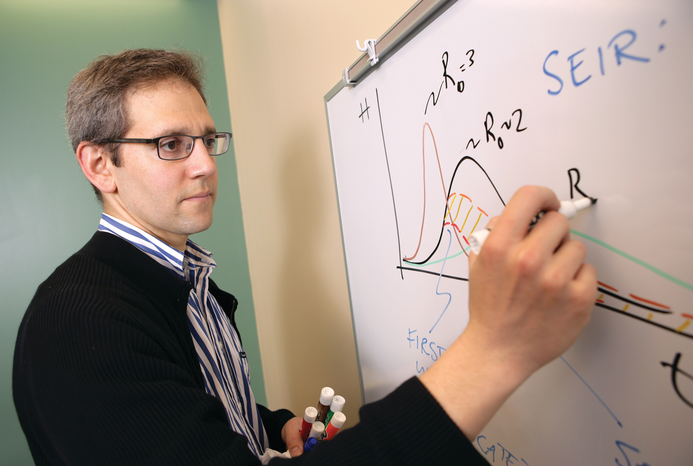Mathematical modeling by Weill Cornell Medicine is helping to guide New York State and New York City leaders as they make decisions that could affect the trajectory of the COVID-19 pandemic.
Using a tool he created called the Cornell COVID Caseload Calculator C5V, Dr. Nathaniel Hupert, associate professor of population health sciences at Weill Cornell Medicine, has been making forecasts of the potential impact of COVID-19 on local and regional healthcare systems. The data helps the state’s and city’s leaders answer questions like when cases of the disease will peak in hospitals and what resources will be needed to successfully care for those patients.
Along with two other COVID-19 modeling groups in New York City and several in Albany, Dr. Hupert is working to accurately anticipate the health consequences of the COVID-19 pandemic in order to better plan for anticipated surges in patient arrivals. Using a second, more epidemiologically oriented model created with the University of Oxford and an international modeling coalition called the CoMo Collaborative, he is also modeling how eventual lifting of restrictions on social interaction will influence further disease spread and subsequent demands on the healthcare system. This 152-country model will shortly be released online.
“What we hope to achieve with this work is not only to better prepare hospitals to care for the oncoming waves of patients affected by this pandemic, but also help health planners and political leaders find a way out of the need for social distancing and other lockdown procedures in a way that maximally sustains the health of populations here in the United States and around the world,” he said.
Models such as these are only as good as the data on which they are based, Dr. Hupert said. Each day, he receives data from state and city health officials on the number of COVID-19 tests administered throughout the state and their results, the numbers of patients admitted to hospitals throughout New York State, the availability of hospital beds and ventilators, and deaths from SARS-CoV-2, the virus that causes COVID-19.
Even very simple modeling frameworks, which produce what in modeling circles are called “toy models,” can help both scientists and policy makers better understand the problem at hand. Dr. Hupert notes that problems may arise when these simple models are taken to reflect—or worse, predict—reality on the ground. He notes, for example, that models that assume that all outbreaks of COVID-19 will exhibit an exponential rise in cases may hold true only for a brief period of time – or never in certain locations. This is because it takes sophisticated models to be able to capture the full complexity of how this novel virus is now traveling through real and varied communities – such as the different boroughs of New York City—and it takes teams of dedicated mathematicians and physicists weeks to properly determine the correct values to accurately reflect what is known about the current outbreak.
“It's possible that introduction of this virus into medically vulnerable communities across the city and country is like a spark that causes early ‘hotspots,’ which leave in their wake very local concentrations of hospitalizations, illness and suffering for those who may have the least means to manage them. As the virus moves on to other locales, through transmission mechanisms that we are still trying to discover, we see the emergence of the larger wave of infections that even simple models can then represent,” he explained.
Hupert, whose work in public health emergency preparedness and support for New York City and national leaders predates 9/11, originally created the framework for the Cornell COVID Caseload Calculator C5V with two faculty from Cornell University’s School of Operations Research and Information Engineering. Working on the 2014 West Africa Ebola outbreak for the U.S. federal government, Dr. Hupert turned to Drs. John A. (“Jack”) Muckstadt and Peter L. Jackson to help build models to predict how large Ebola medical treatment facilities would need to be to work effectively. The process of creating the Cornell Calculator helped speed the development of the hospital component of the COVID19 International model, which he and his colleagues in the CoMo Collaborative are making freely available to help hospital leaders across the country and around the world during the current crisis.
“Dr. Nathaniel Hupert has dedicated his career to disaster preparedness,” said Dr. Rainu Kaushal, chair of the Department of Population Health Sciences and senior associate dean for clinical research at Weill Cornell Medicine. “He is applying decades of knowledge to this moment in history to help us understand and rapidly plan for this pandemic. I am proud of his remarkable contributions to assist people across the world, especially New Yorkers.”

